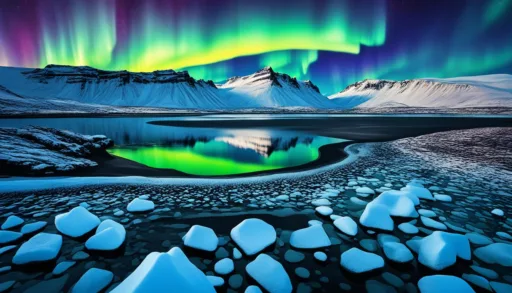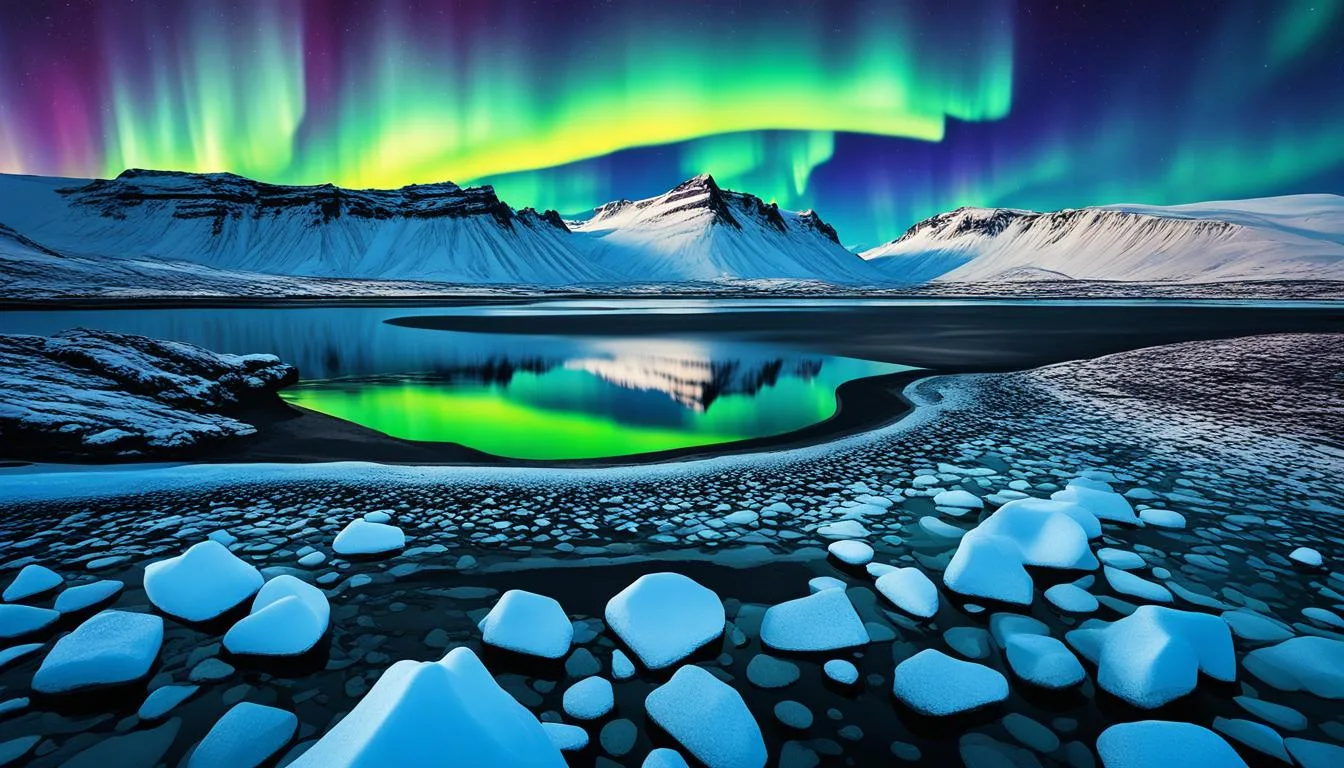Imagine a land where the sky dances with ethereal colors and twilight lingers long enough to forget the stars. This is Iceland, a country that defies the ordinary and births extraordinary experiences. The best time to visit Iceland depends on which of these surreal phenomena you are chasing: the mesmerizing Northern Lights or the endless glow of the Midnight Sun. As you embark on your Iceland vacation planning, consider that your choice might just redefine the very nature of day and night for you. This guide offers essential travel tips for Iceland and insights into the ideal time to go to Iceland for those unforgettable moments.
Key Takeaways
- Deciding when to visit Iceland hinges on personal preferences for natural spectacles: the aurora borealis in winter or the Midnight Sun in summer.
- Optimal viewing of the Northern Lights is possible from October to March, with dark nights providing a perfect canvas for the light show.
- The Midnight Sun dominates summer months, offering unique travel opportunities under nearly 24-hour daylight.
- Weather patterns and natural cycles are crucial for planning the best Icelandic vacation experience.
- Tailored travel tips for Iceland assure a smooth journey in the pursuit of these celestial wonders.
- Finding the ideal time to go to Iceland requires flexibility and readiness to embrace the country’s seasonal moods.
Discover the Splendors of Iceland’s Nights: Aurora Borealis & Solstice Sun
Whether you are drawn to the luminous dance of the Northern Lights Iceland or the ethereal daylight of the summer solstice, Iceland provides a front-row seat to some of the most spectacular natural phenomena on Earth. The contrasting yet equally mesmerizing experiences of aurora borealis in winter and the Midnight Sun during summer in Iceland are the jewels in the country’s celestial crown.
Understanding Iceland’s Unique Celestial Shows
The skies above this arctic paradise offer visitors a unique display of colors and lights, attributed to its proximity to the North Pole. During the winter season, the frequency and intensity of the Northern Lights can turn a typical night under the weather in Iceland into a spectacular light show, making it the best time to visit Iceland for those chasing the auroras. Solar winds collide with the magnetosphere, painting vibrant hues across the sky—a sight that continues to draw travelers from all corners of the world.
Seasonal Variations and Optimal Viewing Conditions
The sightings of these nocturnal rainbows peak when the nights are at their longest and darkest, usually from October through March. While the country’s weather in Iceland can be unpredictable, the crisp clear nights of winter present the optimal conditions for this natural light display. The ideal setting includes a balance of factors: dark skies, limited light pollution, and active solar winds.
Witnessing the Midnight Sun: Summer Solstice Magic
As the Earth’s axis tilts towards the sun, summer in Iceland offers an entirely different wonder, with nearly 24 hours of sunlight around the June solstice. During this magical period, the sun barely sets, inviting a plethora of activities under the surreal illumination of the Midnight Sun. This is an ideal time to go to Iceland for those looking to explore the island’s natural wonders without night’s interruption. It’s a time when the country awakens for non-stop adventure under a sky that never sleeps.
Best Time to Visit Iceland for Northern Lights Enthusiasts
Exploring Iceland in search of the elusive Northern Lights or aurora borealis is a captivating experience for any traveler. While these natural light displays can be seen in various parts of the world, Iceland offers some of the most vivid. To maximize your chances of witnessing this otherworldly phenomenon, timing is crucial; understanding the peak season in Iceland plays a key role in your travel planning.

The period between September and April presents the optimal darkness levels necessary for Northern Lights viewing. During these months, Iceland’s position close to the Arctic Circle combined with the long, polar nights creates ideal conditions for aurora activity. Observers should pay close attention to the KP index, which quantifies geomagnetic disturbances. A higher KP index correlates with an increased likelihood of Northern Lights occurrence, painting the sky with a vibrant spectrum of colors.
- November to January: Known for the darkest nights, offering the longest potential viewing times.
- January: Often highlighted as the best time to visit Iceland for Northern Lights enthusiasts due to its extended darkness and potential for snow-covered landscapes.
- Prime viewing hours: Generally between 10 PM and 2 AM, when the sky is darkest.
For visitors determined to experience this awe-inspiring spectacle, enduring the chilly Icelandic nights is a small price to pay. Travel tips for Iceland include: dressing warmly, checking the aurora forecast regularly, and staying flexible with your itinerary to allow for sudden changes in weather.
Embarking on this celestial quest can lead you through some of Iceland’s most staggering winter scenery, from the mystical blue ice caves to the tranquil, snow-blanketed fjords—all while in pursuit of the aurora borealis, a truly unforgettable highlight of any Icelandic adventure.
Planning Your Iceland Adventure: Navigating Weather and Peak Seasons
The enchanting Land of Fire and Ice provides unparalleled opportunities for adventure seekers. Yet, the key to ensuring an unforgettable Iceland vacation lies in meticulous planning, especially around the unpredictable weather in Iceland and the peak seasons that could impact your journey. By aligning your travel plans with the ideal time to go to Iceland, you can optimize your experience whether you’re looking to witness the phenomenal Northern Lights or bask in the country’s stark winter beauty.
Winter Wonders: Ideal Months for an Icy Expedition
The months of November through January are a pinnacle period for those wishing to marvel at Iceland’s icicle-clad landscapes and ethereal aurora displays. During these peak season months, the nights grow long and dark—a perfect canvas for the Northern Lights. As debutantes in Iceland vacation planning will learn, these winter months offer a delicate balance between awe-inspiring celestial shows and challenging meteorological conditions.
Travel tips for Iceland frequently underscore how imperative it is to monitor forecasts when venturing into this wintery realm. Conditions can swiftly transition from serene to stormy, with the Icelandic Met Office providing indispensable guidance. Traversing Iceland’s seasons requires not just thermal attire but also a spirit willing to embrace the unexpected.
Tips to Balance Comfort and Optimal Visibility During Your Stay
- Prepare for Variability: Ensure your luggage contains layers for warmth, waterproof outerwear, and sturdy boots. The weather in Iceland can fluctuate rapidly, and being adequately prepared can make the difference between discomfort and delight.
- Extend Your Stay: To circumvent the whims of weather and increase your chances of witnessing the auroras, consider lengthening your trip. This flexibility can be crucial during peak season in Iceland when sightings can never be guaranteed.
- Stay Informed: Regularly consult the Icelandic Met Office’s website for comprehensive weather updates and aurora forecasts. Information is power, especially when planning night excursions under Iceland’s capricious skies.
- Embrace Patience: The Northern Lights, elusive and ephemeral, reward those who wait. Dedicate several nights for potential sightings, and don’t let any single cloudy night dishearten your quest.
Embarking on an Iceland adventure necessitates a blend of excitement and practicality. Wise travelers who eagerly anticipate gazing upon the auroras will harvest the benefits of their Iceland vacation planning efforts by respecting nature’s schedule and heeding local expertise. Let the crescendo of Iceland’s winter weather patterns play a harmonious background to the trip of your lifetime.
Northern Lights Iceland: Chasing the Aurora Borealis
Embarking on a quest to witness the Northern Lights in Iceland can be one of the most captivating experiences for any avid traveler. Understanding the weather in Iceland and the solar patterns is critical for anyone looking to capture the stunning aurora borealis in the night sky. To aid in your Iceland vacation planning, here are some essential travel tips for Iceland to enhance your chances of encountering this natural spectacle.

For the most successful aurora hunt, your preparation should include knowledge of the KP index—a measure of geomagnetic activity that can affect the visibility of the Northern Lights. A KP index of three or above often suggests a higher likelihood of a display. This index, together with real-time updates from the Icelandic Met Office, can be indispensable tools for predicting when and where the lights may appear.
Seize the opportunity to explore Iceland’s more secluded locations, as these are the places where the darkness of the sky matches the country’s tranquility, providing the ideal time to go to Iceland for aurora seekers. Consider staying at accommodations that offer northern lights wake-up calls so that even during your rest, you won’t miss out on a sudden flare-up of the auroras.
| Key Factor | Description | Traveler Tips |
|---|---|---|
| KP Index | Measures geomagnetic strength | Monitor for values >3 |
| Location | Remote areas with dark skies | Stay outside urban centers |
| Time | Hours of darkness | Optimal between 10 PM and 2 AM |
| Weather | Clear and cloudless skies | Check the Icelandic Met Office forecasts |
| Accommodation Services | Aurora alarm services | Choose hotels that offer nocturnal alerts |
Alongside these travel tips for Iceland, a successful view of the aurora borealis also requires patience and flexibility, as this natural light show is as unpredictable as it is beautiful. With well-timed Iceland vacation planning, you stand the best chance of witnessing the celestial dance of the Northern Lights, creating unforgettable memories against the backdrop of Iceland’s stunning nocturnal landscapes.
Embracing Iceland’s Midnight Sun: An Ethereal Experience
Those seeking the ultimate summer in Iceland will find themselves enthralled by an otherworldly spectacle known as the Midnight Sun. During this unique time, the sun barely sets, painting the landscape in a perpetual golden hue that lasts through the night. This phenomenon creates an ethereal ambience that is perfect for travelers who wish to soak in every bit of their journey without the rush of nightfall.

The Phenomenon of Constant Daylight: When to Experience It
The best time to visit Iceland for a Midnight Sun experience is around the summer solstice, typically in June. This is when the sun graces the horizon without a full set, leaving the country in an enchanting twilight for 24 hours. It’s an idyllic period for adventurers and sightseers alike, urging an addition to any Iceland vacation planning checklist. The Midnight Sun offers a surreal counterpoint to the dark winters famed for the Northern Lights, presenting its own version of natural magic.
Unique Activities Under the Midnight Sun
Travel tips for Iceland often highlight the Midnight Sun as an ideal time to go to Iceland for those looking to engage in activities normally reserved for daylight hours. Here are some unique experiences you can enjoy:
- Midnight Golfing: Tee off under a sunlit sky even at midnight, a once-in-a-lifetime opportunity for golf enthusiasts.
- Late-Night Hiking: Summit a glacier or traverse the volcanic landscapes without the need for a headlamp.
- Wildlife Watching: Observe whales and puffins in a different light, as these creatures continue their routines oblivious to the unusual human perception of day and night.
These activities harness the full potential of the Midnight Sun, allowing visitors to experience the land of fire and ice in a new dimension. Whether part of a tour or a solo adventure, the constant daylight opens up opportunities for exploration without the typical boundaries set by the sunset.
Iceland Vacation Planning: From Northern Lights to Solar Glow
Embarking on an Iceland adventure entails more than just packing your bags; it requires meticulous Iceland vacation planning and knowledge of travel tips for Iceland. Whether you dream of marveling at the Northern Lights Iceland offers, or basking in the endless day during the ideal time to go to Iceland, follow these strategic steps to enhance your journey.
Comprehensive Guides and Tips for Traveling in Iceland
Meticulous planning is a must for conquering the unique Icelandic climate and making the most of every Icelandic marvel. A well-crafted itinerary can help you make the most out of your daylight hours while leaving room for spontaneous explorations under the night sky.
Tools and Resources for the Perfect Northern Lights Hunt
Chasing the elusive Northern Lights is all about timing and technology. Here’s a tailor-made table highlighting vital tools to aid your quest for this spectacular light show:
| Tool | Purpose | Features |
|---|---|---|
| Icelandic Met Office | Cloud Cover Forecast | Detailed local cloud cover predictions to determine visibility opportunities |
| SolarHam | Geomagnetic Forecast | Updates on solar activity to anticipate geomagnetic conditions conducive to Northern Lights sightings |
| Aurora Forecast App | Visibility and Probability | Real-time aurora activity forecast with notifications for increased sighting probabilities |
Leverage these resources to stay ahead and witness the breathtaking dance of the auroras across Iceland’s nocturnal canvas.
Capturing the Moments: Photography Tips for Night-Time Wonders
Capturing the spellbinding beauty of the Northern Lights demands more than a mere click of the camera. Here are some essential photography tips to immortalize this celestial ballet:
- Use a manual focus setting to ensure the sharpest shots in low light conditions.
- Adjust the ISO to balance light sensitivity with minimal noise.
- Employ a tripod and long exposure to depict the aurora’s colors vibrantly.
- Experiment with various shutter speeds to capture different movements of the lights.
With some practice and these handy tips, you’ll leave Iceland with not only memories but also stunning photographs of its most iconic natural spectacles.

Conclusion
In mapping out the ideal time to visit Iceland, the spectacular drawcards of the Northern Lights and the Midnight Sun each beckon with their own unique allure. For those mesmerized by the dance of celestial colors, the dark canvas of Iceland’s winter skies from October to March is a prime stage for the Northern Lights. Conversely, those wishing to soak in the perpetual daylight will find the months of June through August painted with the Midnight Sun’s persistent glow. Choosing between these peak seasons in Iceland is less a matter of chance and more a strategic decision guided by personal preference.
Iceland vacation planning is an art that marries diligence with anticipation. The use of forecasting tools and a mindful consideration of travel tips for Iceland significantly enhance one’s chances of encountering the natural marvels the country is famed for. Patience is your steadfast companion, and preparation, your trusted ally, as you embark on a journey through the Icelandic panoramas that host some of the planet’s most remarkable celestial displays.
Whether it’s the profound silence under the ethereal lights or the vibrant laughter under a sun that refuses to set, an Icelandic experience is crafted through thoughtful planning and adaptability. While guides can direct your gaze to the skies, it is the readiness to embrace Mother Nature’s whims that ultimately ensures a profound and memorable encounter with Iceland’s natural spectacles. The Northern Lights Iceland travelers relentlessly pursue, and the Midnight Sun that captivates with endless day, are but the opening acts to the myriad of wonders awaiting in Iceland’s embrace.






